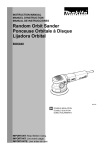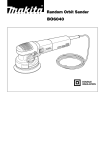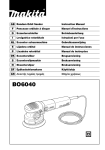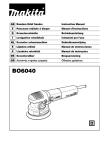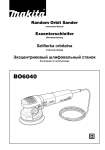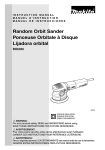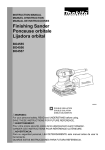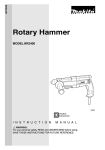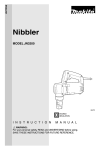Download Makita BO6040 003278 Specifications
Transcript
ENGLISH Random Orbit Sander MODEL BO6040 003278 DOUBLE INSULATION I N S T R U C T I O N M A N U A L WARNING: For your personal safety, READ and UNDERSTAND before using. SAVE THESE INSTRUCTIONS FOR FUTURE REFERENCE. SPECIFICATIONS Model BO6040 Pad diameter 150 mm Abrasive disc diameter -1 150 mm Orbits per minute (min ) 1,600 - 5,800 Overall length 316 mm Net weight 2.7 kg Safety class /II • Due to our continuing programme of research and development, the specifications herein are subject to change without notice. • Note: Specifications may differ from country to country. SYMBOLS END201-2 The following show the symbols used for the equipment. Be sure that you understand their meaning before use. ...................Read instruction manual. ...................DOUBLE INSULATION ..................Only for EU countries Do not dispose of electric equipment together with household waste material! In observance of European Directive 2002/96/EC on waste electric and electronic equipment and its implementation in accordance with national law, electric equipment that have reached the end of their life must be collected separately and returned to an environmentally compatible recycling facility. Intended use The tool is intended for the sanding of large surface of wood, plastic and metal materials as well as painted surfaces. Power supply The tool should be connected only to a power supply of the same voltage as indicated on the nameplate, and can only be operated on single-phase AC supply. They are double-insulated in accordance with European Standard and can, therefore, also be used from sockets without earth wire. 2 For European countries only Noise and Vibration The typical A-weighted sound pressure level is 78 dB (A). Uncertainty is 3 dB(A). The noise level under working may exceed 85 dB (A). – Wear ear protection. – The typical weighted root mean square acceleration value is 7 m/s2. These values have been obtained according to EN60745. EC-DECLARATION OF CONFORMITY We declare under our sole responsibility that this product is in compliance with the following standards of standardized documents, EN60745, EN55014, EN61000 in accordance with Council Directives, 89/336/EEC, 98/37/ EC. Yasuhiko Kanzaki CE 2005 Director MAKITA INTERNATIONAL EUROPE LTD. Michigan Drive, Tongwell, Milton Keynes, Bucks MK15 8JD, ENGLAND Responsible manufacturer: Makita Corporation Anjo Aichi Japan GENERAL SAFETY RULES GEA001-3 WARNING: Read all instructions. Failure to follow all instructions listed below may result in electric shock, fire and/or serious injury. The term “power tool” in all of the warnings listed below refers to your mains-operated (corded) power tool or batteryoperated (cordless) power tool. SAVE THESE INSTRUCTIONS Work area safety 1. Keep work area clean and well lit. Cluttered and dark areas invite accidents. 2. Do not operate power tools in explosive atmospheres, such as in the presence of flammable liquids, gases or dust. Power tools create sparks which may ignite the dust or fumes. 3. Keep children and bystanders away while operating a power tool. Distractions can cause you to lose control. Electrical safety moment of inattention while operating power tools may result in serious personal injury. 10. Use safety equipment. Always wear eye protection. Safety equipment such as dust mask, non-skid safety shoes, hard hat, or hearing protection used for appropriate conditions will reduce personal injuries. 11. Avoid accidental starting. Ensure the switch is in the off-position before plugging in. Carrying power tools with your finger on the switch or plugging in power tools that have the switch on invites accidents. 4. Power tool plugs must match the outlet. Never modify the plug in any way. Do not use any adapter plugs with earthed (grounded) power tools. Unmodified plugs and matching outlets will reduce risk of electric shock. 5. Avoid body contact with earthed or grounded surfaces such as pipes, radiators, ranges and refrigerators. There is an increased risk of electric shock if your body is earthed or grounded. 6. Do not expose power tools to rain or wet conditions. Water entering a power tool will increase the risk of electric shock. 7. Do not abuse the cord. Never use the cord for carrying, pulling or unplugging the power tool. Keep cord away from heat, oil, sharp edges or moving parts. Damaged or entangled cords increase the risk of electric shock. Power tool use and care When operating a power tool outdoors, use an extension cord suitable for outdoor use. Use of a cord suitable for outdoor use reduces the risk of electric shock. 16. Do not force the power tool. Use the correct power tool for your application. The correct power tool will do the job better and safer at the rate for which it was designed. 8. Personal safety 9. Stay alert, watch what you are doing and use common sense when operating a power tool. Do not use a power tool while you are tired or under the influence of drugs, alcohol or medication. A 12. Remove any adjusting key or wrench before turning the power tool on. A wrench or a key left attached to a rotating part of the power tool may result in personal injury. 13. Do not overreach. Keep proper footing and balance at all times. This enables better control of the power tool in unexpected situations. 14. Dress properly. Do not wear loose clothing or jewellery. Keep your hair, clothing, and gloves away from moving parts. Loose clothes, jewellery or long hair can be caught in moving parts. 15. If devices are provided for the connection of dust extraction and collection facilities, ensure these are connected and properly used. Use of these devices can reduce dust-related hazards. 17. Do not use the power tool if the switch does not turn it on and off. Any power tool that cannot be controlled with the switch is dangerous and must be repaired. 18. Disconnect the plug from the power source and/ or the battery pack from the power tool before 3 making any adjustments, changing accessories, or storing power tools. Such preventive safety measures reduce the risk of starting the power tool accidentally. 5. 19. Store idle power tools out of the reach of children and do not allow persons unfamiliar with the power tool or these instructions to operate the power tool. Power tools are dangerous in the hands of untrained users. 7. 20. Maintain power tools. Check for misalignment or binding of moving parts, breakage of parts and any other condition that may affect the power tools operation. If damaged, have the power tool repaired before use. Many accidents are caused by poorly maintained power tools. 6. 8. 9. This tool has not been waterproofed, so do not use water on the workpiece surface. Ventilate your work area adequately when you perform sanding operations. Some material contains chemicals which may be toxic. Take caution to prevent dust inhalation and skin contact. Follow material supplier safety data. Use of this tool to sand some products, paints and wood could expose user to dust containing hazardous substances. Use appropriate respiratory protection. Be sure that there are no cracks or breakage on the pad before use. Cracks or breakage may cause a personal injury. 21. Keep cutting tools sharp and clean. Properly maintained cutting tools with sharp cutting edges are less likely to bind and are easier to control. SAVE THESE INSTRUCTIONS. 22. Use the power tool, accessories and tool bits etc. in accordance with these instructions and in the manner intended for the particular type of power tool, taking into account the working conditions and the work to be performed. Use of the power tool for operations different from those intended could result in a hazardous situation. WARNING: MISUSE or failure to follow the safety rules stated in this instruction manual may cause serious personal injury. Service 23. Have your power tool serviced by a qualified repair person using only identical replacement parts. This will ensure that the safety of the power tool is maintained. 24. Follow instruction for lubricating and changing accessories. 25. Keep handles dry, clean and free from oil and grease. GEB021-1 Specific Safety Rules DO NOT let comfort or familiarity with product (gained from repeated use) replace strict adherence to sander safety rules. If you use this tool unsafely or incorrectly, you can suffer serious personal injury. 1. Hold power tools by insulated gripping surfaces when performing an operation where the cutting tool may contact hidden wiring or its own cord. Contact with a “live” wire will make exposed metal parts of the tool “live” and shock the operator. 2. Always use safety glasses or goggles. Ordinary eye or sun glasses are NOT safety glasses. 3. Hold the tool firmly. 4. Do not leave the tool running. Operate the tool only when hand-held. 4 FUNCTIONAL DESCRIPTION • 003287 CAUTION: Always be sure that the tool is switched off and unplugged before adjusting or checking function on the tool. Switch action CAUTION: Before plugging in the tool, always check to see that the slide switch actuates properly and returns to the “OFF” position when the rear of the slide switch is depressed. To start the tool, slide the slide switch toward the “I (ON)” position. For continuous operation, press the front of the slide switch to lock it. To stop the tool, press the rear of the slide switch, then slide it toward the “O (OFF)” position. • 1 1. Slide switch 003289 Speed adjusting dial The rotating speed can be changed by turning the speed adjusting dial to a given number setting from 1 to 5. Higher speed is obtained when the dial is turned in the direction of number 5. And lower speed is obtained when it is turned in the direction of number 1. Refer to the table for the relationship between the number settings on the dial and the approximate rotating speed. 003290 1 1. Speed adjusting dial Number Orbits per min. 1 2 3 4 5 1,600 2,100 3,600 5,100 5,800 Roto-orbit pad rotating speed per min. 180 240 420 590 670 CAUTION: If the tool is operated continuously at low speeds for a long time, the motor will get overloaded, resulting in tool malfunction. • The speed adjusting dial can be turned only as far as 5 and back to 1. Do not force it past 5 or 1, or the speed adjusting function may no longer work. The tools equipped with electronic function are easy to operate because of the following features. • Electronic constant speed control Possible to get fine finish, because the rotating speed is kept constantly even under the loaded condition. • Soft start feature Soft start because of suppressed starting shock. • 5 003292 Selecting the action mode Use the change lever to change the rotation mode. Roto-orbit mode is orbital action plus rotation action of pad for rough sanding and polishing. 1 Roto-orbit mode 1. Change lever 003293 Random orbit mode is orbital action of pad for fine sanding. Rotate the change lever counterclockwise for roto-orbit mode and clockwise for random orbit mode. • CAUTION: Do not rotate the change lever when the tool is running. The tool will be damaged. 1 Random orbit mode 1. Change lever Typical applications for sanding and polishing 003294 Sanding Use / Material Paintwork: Sanding Repairs (scratches, rust spots) Rough paint stripping Plastics: Soft plastics (PVC/ABS) Hard plastics (FRP) Woods: Softwood Hardwood Veneers Metals: Non-ferrous metal (aluminum, copper) Steel Steel, rust removal Hard metal (stainless steel) Mode selection Speed control setting Pad Random Roto-orbit/Random Roto-orbit 1-3 2-3 4-5 Soft Hard Soft Roto-orbit/Random Roto-orbit 1-3 1-3 Super soft/Soft Soft/Hard Random Roto-orbit/Random Random 1-3 3-5 1-2 Super soft/Soft Soft Super Soft Roto-orbit/Random Roto-orbit Roto-orbit Roto-orbit 1-3 3-5 4-5 4-5 Soft Soft/Hard Super soft Soft Mode selection Roto-orbit Roto-orbit Roto-orbit Speed control setting 2-4 4-5 4-5 Pad Sponge pad Felt pad Wool pad Polishing Use / Material Applying wax Removing wax Polishing The above information is intended only as a guide. In each case, the most appropriate sanding disc grain should be determined by preliminary trials. 6 ASSEMBLY • 003297 CAUTION: Always be sure that the tool is switched off and unplugged before carrying out any work on the tool. Installing side grip (optional accessory) Remove one of the screws which secure the head cover. Screw the side grip on the tool securely. The side grip can be installed on either side of the tool. 1 1. Side grip 003302 CAUTION: Always use hook-and-loop system abrasive discs. Never use pressuresensitive abrasive discs. To install the abrasive disc, first remove all dirt or foreign matter from the pad. Then attach the abrasive disc to the pad, using the hook-and-loop system of the abrasive disc and the pad. Be careful to align the holes in the abrasive disc with those in the pad. To remove the disc from the pad, just pull up from its edge. • 1 1. Abrasive disc 003315 2 1 Installing or removing abrasive disc Changing pad Makita offers an extensive range of optional super soft, soft and hard pads. Remove the screw counterclockwise from the center of the base with a hex wrench. After changing the pad, tighten the screw clockwise securely. 3 1. Screw 2. Hex wrench 3. Pad 7 003328 3 1 Dust collection (optional accessory) If a Makita hose is used, you can connect the cuff to the dust outlet directly. 2 1. Dust outlet 2. Cuff 3. Hose 003329 If other hose with an inner diameter of 24 mm, attach the joint between the dust outlet and the cuff. 003338 Sanding operation 1 1. Joint OPERATION CAUTION: Never switch on the tool when it is in contact with the workpiece, it may cause an injury to operator. • Never run the tool without the abrasive disc. You may seriously damage the pad. • Never force the tool. Excessive pressure may decrease the sanding efficiency, damage the abrasive disc or shorten tool life. Hold the tool firmly. Turn the tool on and wait until it attains full speed. Then gently place the tool on the workpiece surface. Keep the pad flush with the workpiece and apply slight pressure on the tool. • Polishing operation • • • 8 CAUTION: Use only a Makita genuine sponge pad, felt pad or wool pad (optional accessories). Always operate the tool at low speed to prevent work surfaces from damage/burning. Never force the tool. Excessive pressure may decrease the polishing efficiency and cause motor overload, resulting in tool malfunction. 003340 1. Applying wax Use an optional sponge pad. Apply wax to the sponge pad or work surface. Run the tool at low speed to smooth out wax. NOTE: • First, wax a not conspicuous portion of the work surface to make sure that the tool will not scratch the surface or result in uneven waxing. 003342 2. Removing wax Use an optional felt pad. Run the tool at low speed to remove wax. 003344 3. Polishing Use an optional wool pad. Run the tool at low speed and apply the wool pad gently to the work surface. 1 1. Sponge pad 1 1. Felt pad 1 1. Wool pad MAINTENANCE CAUTION: Always be sure that the tool is switched off and unplugged before attempting to perform inspection or maintenance. To maintain product SAFETY and RELIABILITY, repairs, carbon brush inspection and replacement, any other maintenance or adjustment should be performed by Makita Authorized Service Centers, always using Makita replacement parts. • 9 ACCESSORIES CAUTION: These accessories or attachments are recommended for use with your Makita tool specified in this manual. The use of any other accessories or attachments might present a risk of injury to persons. Only use accessory or attachment for its stated purpose. If you need any assistance for more details regarding these accessories, ask your local Makita service center. • • • • • • 10 Hook-and-loop type abrasive discs (with pre-punched holes) Hook-and-loop type sponge pad Hook-and-loop type felt pad Hook-and-loop type wool pad Sanding cloth • • • • Joint Pad 150 (Super soft, Soft, Hard) Side grip Hex wrench Memo 11 Makita Corporation Anjo, Aichi, Japan 884338B225












